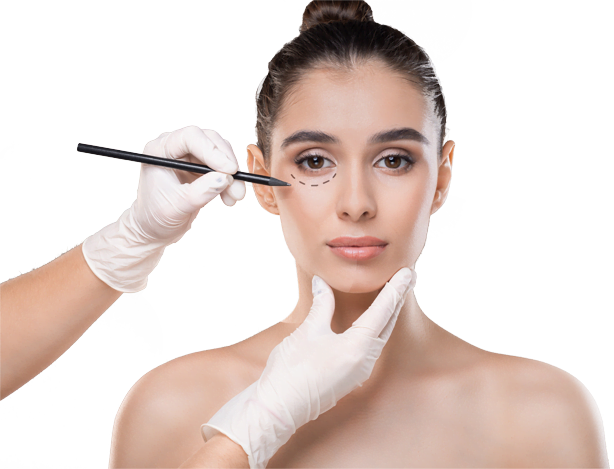Chin contouring, also referred to as genioplasty or mentoplasty, is a surgical procedure that aims to enhance the appearance and proportion of the chin. It involves reshaping the chin bone or augmenting it with the use of implants. Chin contouring can address various concerns such as a weak or receding chin, asymmetry, or disproportionate facial features.
Table of Contents
2. Types of Chin Contouring Procedures
2.1 Sliding Genioplasty
Sliding genioplasty is a surgical technique used to reposition the chin bone. The surgeon makes an incision inside the mouth or under the chin to access the bone. They then make a precise cut in the chin bone, allowing it to be moved forward or backward as needed. Once the desired position is achieved, the bone is secured with plates and screws. Sliding genioplasty provides flexibility in chin augmentation, allowing for customized adjustments.
2.2 Chin Implants
Chin implants involve the placement of synthetic materials, typically silicone, to augment the size and projection of the chin. The surgeon makes an incision either inside the mouth or beneath the chin to create a pocket for the implant. The implant is carefully positioned and secured, resulting in a more prominent and well-defined chin. Chin implants come in various shapes and sizes to suit individual needs.
2.3 Reduction Genioplasty
Reduction genioplasty is performed when a person desires a reduction in the size or projection of their chin. It involves removing a portion of the chin bone to achieve the desired contour. The surgeon carefully plans the amount of bone to be removed to ensure a balanced and proportionate result.
3. Benefits of Chin Contouring
Chin contouring offers several benefits for individuals seeking to improve their facial harmony and aesthetics. Some of the key advantages include:
- Enhanced facial balance: Chin contouring can bring harmony to the facial features by creating a more proportionate and balanced appearance.
- Increased self-confidence: A well-defined and proportionate chin can significantly boost self-confidence and improve one’s overall self-image.
- Correction of asymmetry: Chin contouring can correct asymmetry issues, such as a chin that deviates to one side or is noticeably uneven.
- Improved profile: A weak or receding chin can negatively affect the profile view. Chin contouring can provide a more aesthetically pleasing profile.
- Personalized results: With different techniques and implant options available, chin contouring can be tailored to individual preferences and desired outcomes.
4. Preparation for Chin Contouring Surgery
Before undergoing chin contouring surgery, it is essential to have a consultation with a qualified plastic surgeon. During the consultation, the surgeon will evaluate your facial structure, discuss your goals, and recommend the most suitable approach. Preparing for chin contouring surgery may involve:
- Medical evaluation: The surgeon will assess your overall health and may request blood tests or other diagnostic procedures.
- Medication adjustments: You may need to adjust certain medications that can interfere with the surgery or recovery process, such as blood thinners.
- Smoking cessation: If you smoke, the surgeon may advise quitting several weeks before the procedure to minimize the risk of complications.
- Lifestyle modifications: The surgeon may recommend certain lifestyle modifications, such as maintaining a healthy diet and exercise routine, to optimize the surgical outcome.
5. The Chin Contouring Procedure
The chin contouring procedure is typically performed under general anesthesia or local anesthesia with sedation. The specific technique used will depend on the chosen approach, whether it is sliding genioplasty, chin implants, or reduction genioplasty. The surgeon will make incisions in discreet locations to minimize visible scarring.
Once the necessary adjustments to the chin bone or implant placement are complete, the surgeon will close the incisions with sutures. They may also use surgical tape or dressings to provide support and aid in the healing process. The duration of the procedure can vary depending on the complexity of the case but generally ranges from one to two hours.
6. Recovery and Aftercare
Following chin contouring surgery, it is crucial to follow the surgeon’s post-operative instructions to ensure proper healing and minimize complications. Some general guidelines for recovery and aftercare include:
- Rest and limited physical activity: Adequate rest is essential for the initial phase of recovery. Strenuous activities should be avoided for several weeks.
- Pain management: The surgeon may prescribe pain medication to alleviate any discomfort during the recovery period.
- Swelling and bruising: Swelling and bruising around the chin and lower face are common after the surgery. Applying cold compresses and keeping the head elevated can help reduce these symptoms.
- Oral hygiene: Good oral hygiene practices, including gentle brushing and rinsing with a prescribed mouthwash, are important to prevent infection.
- Follow-up appointments: Regular follow-up appointments with the surgeon will allow them to monitor your progress and address any concerns or complications that may arise.
7. Potential Risks and Complications
As with any surgical procedure, chin contouring carries some risks and potential complications. These can include:
- Infection: Although rare, there is a risk of developing an infection at the incision site.
- Bleeding: Excessive bleeding during or after the surgery can occur but is uncommon.
- Nerve damage: There is a possibility of temporary or permanent damage to the nerves in the chin area, leading to altered sensation or movement.
- Implant complications: If chin implants are used, there is a risk of implant displacement, asymmetry, or an unfavorable reaction to the implant material.
- Scarring: While efforts are made to minimize visible scarring, there is always a possibility of noticeable scars, especially with open incisions.
8. Expected Results
The final results of chin contouring surgery may not be immediately visible due to initial swelling and bruising. However, as the healing progresses and swelling subsides, the improved chin contour and facial harmony will become apparent. The results of chin contouring are generally long-lasting, providing a more balanced and aesthetically pleasing appearance.
9. Alternative Options for Chin Enhancement
In addition to surgical chin contouring, there are non-surgical options available for chin enhancement. These can include:
- Injectable fillers: Dermal fillers can be used to augment the chin temporarily. However, the results are not as long-lasting as those achieved through surgery.
- Kybella: Kybella is an injectable treatment that targets and reduces excess fat under the chin. It is suitable for individuals with a double chin caused by submental fat.
It is important to consult with a qualified plastic surgeon to determine the most suitable option based on individual needs and goals.
10. Choosing a Qualified Surgeon
When considering chin contouring surgery, it is crucial to choose a qualified and experienced plastic surgeon. Some key factors to consider when selecting a surgeon include:
- Board certification: Ensure the surgeon is certified by a recognized board for plastic surgery.
- Experience and expertise: Look for a surgeon who has extensive experience in performing chin contouring procedures and can provide before-and-after photos of their previous patients.
- Patient reviews and testimonials: Read reviews and testimonials from previous patients to gain insight into the surgeon’s skills and patient satisfaction.
- Consultation: Schedule a consultation with the surgeon to discuss your goals, ask questions, and assess their communication style and professionalism.
11. Cost of Chin Contouring
The cost of chin contouring surgery can vary depending on several factors, including the surgeon’s expertise, geographic location, facility fees, anesthesia fees, and the specific technique used. It is important to discuss the cost with the surgeon during the initial consultation, as they can provide a personalized estimate based on your unique case.
12. Frequently Asked Questions
12.1 How long does the procedure take?
The duration of the chin contouring procedure can vary depending on the complexity of the case. However, it generally ranges from one to two hours.
12.2 Is chin contouring a painful procedure?
Chin contouring surgery is typically performed under anesthesia, so you will not experience any pain during the procedure. Some discomfort and swelling can be expected during the recovery period, but these can be managed with pain medication prescribed by your surgeon.
12.3 Will there be visible scarring?
Efforts are made to minimize visible scarring by placing incisions in discreet locations. However, there is always a possibility of noticeable scarring, especially with open incisions. Over time, the scars tend to fade and become less noticeable.
12.4 How soon can I return to work or daily activities?
The recovery time can vary for each individual, but most people can resume work and daily activities within one to two weeks after the surgery. Strenuous activities and exercise should be avoided for several weeks to ensure proper healing.
12.5 Are there any non-surgical alternatives to chin contouring?
Yes, there are non-surgical options available for chin enhancement. These include injectable fillers, which can provide temporary augmentation, and Kybella injections, which reduce submental fat. However, the results of non-surgical options are not as long-lasting as those achieved through surgery.
Conclusion
Chin contouring, also known as genioplasty or mentoplasty, is a surgical procedure that can enhance the appearance and proportion of the chin. It offers numerous benefits, including improved facial balance, increased self-confidence, and correction of asymmetry. With different techniques available, such as sliding genioplasty, chin implants, and reduction genioplasty, chin contouring can be customized to suit individual needs and desired outcomes. It is essential to consult with a qualified plastic surgeon to discuss the procedure, risks, recovery, and expected results. By following the appropriate pre-operative and post-operative instructions, individuals can achieve a more balanced and harmonious facial profile through chin contouring.

